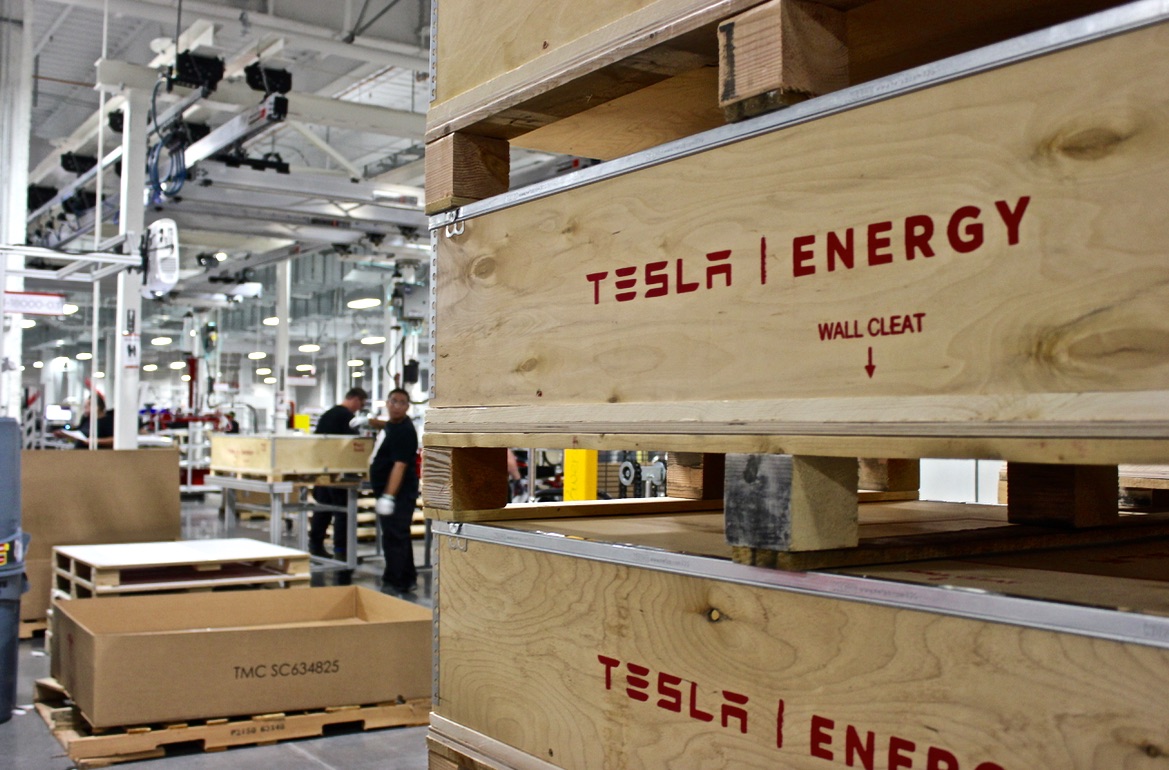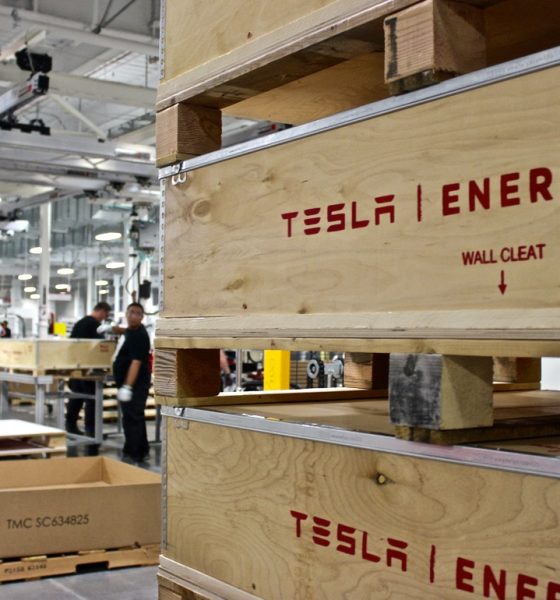

News
Tesla “Battery Day” event date is looking like April 2020, says Elon Musk
Tesla CEO Elon Musk said the company is preparing to host a Battery Day for shareholders sometime after the first quarter, possibly in April. The announcement came during the earnings call following Tesla’s release of its Q4 2019 Update Letter.
Responding to a question from a participating investor about where Tesla stands in growing its battery capacity, Musk said that the company has already demonstrated massive improvement in growing the capacity of the cells, modules, and batteries it uses for its all-electric vehicles.
The CEO attributed part of the improvements to Tesla’s relationships with various battery partners, such as Panasonic, which is Tesla’s in-house supplier of lithium-ion batteries at Giga Nevada. Tesla also teamed up with other partners such as LG and CATL to produce battery packs for its cars produced in China. Aside from that, Musk declined to provide additional details on future plans for improving its battery technology, leaving investors to look forward to the upcoming Battery Day event later this year.
“We have a lot more to talk about this in detail in Battery Day probably April. We have a very compelling strategy. I mean, we are super deep in cell. Super deep. Cell through battery,” he said.
Tesla’s efforts to upgrade its batteries include the acquisition of California-based energy storage firm Maxwell Technologies, which was completed in May last year. Tesla’s interest in Maxwell primarily lies in the latter’s innovations in ultracapacitors and dry electrode technologies, which could potentially improve the company’s batteries.
Prior to the acquisition, Tesla also submitted a patent for an idea to use electrolyte additives to improve the performance and lengthen the lifespan of lithium-ion cells. The patent, titled “Dioxazolones and Nitrile Sulfites as Electrolyte Additives for Lithium-ion Batteries,” provided details on how Tesla can significantly increase the lifespan and performance of its batteries by adding electrolyte additives such as lithium salt. Tesla also submitted another patent for using cold plates and heat pipes to reduce heat generated by the battery, thereby increasing the longevity of its energy storage systems.
The latest developments appear to be moving Tesla toward the completion of a 1-million mile battery. In April last year, Musk said that Tesla owners will soon be able to drive their cars for up to 1 million miles over the lifespan of their vehicles. This is equivalent to 20 years if the cells are used for energy storage systems. Tesla lead researcher Jeff Dahn and a team from the Dalhousie University physics and atmospheric science department have also developed pouch cells that can last 1 million miles or 20 years in a grid storage system.
Tesla’s huge lead in the electric vehicle market is due in part to its constant efforts to improve its battery technology. In fact, its batteries have improved so much over the years that the Model S is nearing a range of 400 miles. The published range for the luxury sedan is 373 miles, but Musk said during the earnings call that the actual range is somewhere in the 380s.
“S and X actually have more range than we are currently stating on the website. We just haven’t gotten around to updating the EPA […] number, but the actual range of the Model S and X are above what the website says they are,” he said. “Somewhere in the 380s, something like that.”
He also added that the 18650 lithium-ion cells that power the Model S and X have largely improved over the years, adding that further developments could raise the range of the Model S to 400 miles.
“I think we’re pretty happy with the energy content of the cell and the improvements in the efficiency of the vehicle,” he said. “We’re rapidly approaching a 400-mile range for the Model S, for example.”
Battery Day is expected to be similar to Autonomy Day, which was held in April last year. The event, which was attended by investors and also available via livestream, was a full three-hour technical discussion of Tesla’s work on autonomous driving technology and how the company plans to achieve its goal of delivering fully self-driving cars.

News
Nvidia CEO Jensen Huang explains difference between Tesla FSD and Alpamayo
“Tesla’s FSD stack is completely world-class,” the Nvidia CEO said.

NVIDIA CEO Jensen Huang has offered high praise for Tesla’s Full Self-Driving (FSD) system during a Q&A at CES 2026, calling it “world-class” and “state-of-the-art” in design, training, and performance.
More importantly, he also shared some insights about the key differences between FSD and Nvidia’s recently announced Alpamayo system.
Jensen Huang’s praise for Tesla FSD
Nvidia made headlines at CES following its announcement of Alpamayo, which uses artificial intelligence to accelerate the development of autonomous driving solutions. Due to its focus on AI, many started speculating that Alpamayo would be a direct rival to FSD. This was somewhat addressed by Elon Musk, who predicted that “they will find that it’s easy to get to 99% and then super hard to solve the long tail of the distribution.”
During his Q&A, Nvidia CEO Jensen Huang was asked about the difference between FSD and Alpamayo. His response was extensive:
“Tesla’s FSD stack is completely world-class. They’ve been working on it for quite some time. It’s world-class not only in the number of miles it’s accumulated, but in the way it’s designed, the way they do training, data collection, curation, synthetic data generation, and all of their simulation technologies.
“Of course, the latest generation is end-to-end Full Self-Driving—meaning it’s one large model trained end to end. And so… Elon’s AD system is, in every way, 100% state-of-the-art. I’m really quite impressed by the technology. I have it, and I drive it in our house, and it works incredibly well,” the Nvidia CEO said.
Nvidia’s platform approach vs Tesla’s integration
Huang also stated that Nvidia’s Alpamayo system was built around a fundamentally different philosophy from Tesla’s. Rather than developing self-driving cars itself, Nvidia supplies the full autonomous technology stack for other companies to use.
“Nvidia doesn’t build self-driving cars. We build the full stack so others can,” Huang said, explaining that Nvidia provides separate systems for training, simulation, and in-vehicle computing, all supported by shared software.
He added that customers can adopt as much or as little of the platform as they need, noting that Nvidia works across the industry, including with Tesla on training systems and companies like Waymo, XPeng, and Nuro on vehicle computing.
“So our system is really quite pervasive because we’re a technology platform provider. That’s the primary difference. There’s no question in our mind that, of the billion cars on the road today, in another 10 years’ time, hundreds of millions of them will have great autonomous capability. This is likely one of the largest, fastest-growing technology industries over the next decade.”
He also emphasized Nvidia’s open approach, saying the company open-sources its models and helps partners train their own systems. “We’re not a self-driving car company. We’re enabling the autonomous industry,” Huang said.
Elon Musk
Elon Musk confirms xAI’s purchase of five 380 MW natural gas turbines
The deal, which was confirmed by Musk on X, highlights xAI’s effort to aggressively scale its operations.

xAI, Elon Musk’s artificial intelligence startup, has purchased five additional 380 MW natural gas turbines from South Korea’s Doosan Enerbility to power its growing supercomputer clusters.
The deal, which was confirmed by Musk on X, highlights xAI’s effort to aggressively scale its operations.
xAI’s turbine deal details
News of xAI’s new turbines was shared on social media platform X, with user @SemiAnalysis_ stating that the turbines were produced by South Korea’s Doosan Enerbility. As noted in an Asian Business Daily report, Doosan Enerbility announced last October that it signed a contract to supply two 380 MW gas turbines for a major U.S. tech company. Doosan later noted in December that it secured an order for three more 380 MW gas turbines.
As per the X user, the gas turbines would power an additional 600,000+ GB200 NVL72 equivalent size cluster. This should make xAI’s facilities among the largest in the world. In a reply, Elon Musk confirmed that xAI did purchase the turbines. “True,” Musk wrote in a post on X.
xAI’s ambitions
Recent reports have indicated that xAI closed an upsized $20 billion Series E funding round, exceeding the initial $15 billion target to fuel rapid infrastructure scaling and AI product development. The funding, as per the AI startup, “will accelerate our world-leading infrastructure buildout, enable the rapid development and deployment of transformative AI products.”
The company also teased the rollout of its upcoming frontier AI model. “Looking ahead, Grok 5 is currently in training, and we are focused on launching innovative new consumer and enterprise products that harness the power of Grok, Colossus, and 𝕏 to transform how we live, work, and play,” xAI wrote in a post on its website.
Elon Musk
Elon Musk’s xAI closes upsized $20B Series E funding round
xAI announced the investment round in a post on its official website.

xAI has closed an upsized $20 billion Series E funding round, exceeding the initial $15 billion target to fuel rapid infrastructure scaling and AI product development.
xAI announced the investment round in a post on its official website.
A $20 billion Series E round
As noted by the artificial intelligence startup in its post, the Series E funding round attracted a diverse group of investors, including Valor Equity Partners, Stepstone Group, Fidelity Management & Research Company, Qatar Investment Authority, MGX, and Baron Capital Group, among others.
Strategic partners NVIDIA and Cisco Investments also continued support for building the world’s largest GPU clusters.
As xAI stated, “This financing will accelerate our world-leading infrastructure buildout, enable the rapid development and deployment of transformative AI products reaching billions of users, and fuel groundbreaking research advancing xAI’s core mission: Understanding the Universe.”
xAI’s core mission
Th Series E funding builds on xAI’s previous rounds, powering Grok advancements and massive compute expansions like the Memphis supercluster. The upsized demand reflects growing recognition of xAI’s potential in frontier AI.
xAI also highlighted several of its breakthroughs in 2025, from the buildout of Colossus I and II, which ended with over 1 million H100 GPU equivalents, and the rollout of the Grok 4 Series, Grok Voice, and Grok Imagine, among others. The company also confirmed that work is already underway to train the flagship large language model’s next iteration, Grok 5.
“Looking ahead, Grok 5 is currently in training, and we are focused on launching innovative new consumer and enterprise products that harness the power of Grok, Colossus, and 𝕏 to transform how we live, work, and play,” xAI wrote.








